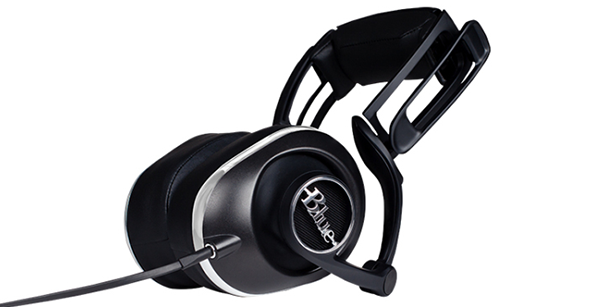The Best Closed Back Studio Headphones in 2023 [$100-$200]
Why Choose Closed Back Studio Headphones?
Headphones and in-ear-monitors have become ubiquitous in our work in the studio. They are practically a necessity when it comes to most overdub sessions, for finding out how our mixes will translate to headphone listeners, and even as a secondary low end check in small studios. Let’s run down some of the best closed back studio headphones in 2023.
While open back headphones will often deliver an even flatter frequency response and improved transient detail, they usually have too much bleed for recording applications, and can sometimes be a bit bass-light compared to closed back models.
Headphones with a closed back design on the other hand, benefit from an accentuated bass response, and offer less leakage than open back designs. In shared environments, they provide more rejection of outside sources, and they also spill less sound out into the surrounding environment, making them less likely to annoy housemates, co-workers and other bystanders.
While the technology of analog headphones hasn’t changed at the rate of their digital counterparts, there have been significant upgrades in quality over the decades, making them more durable and a better choice for critical listening than ever before in the past.
Bear in mind that all headphones are somewhat colored in their frequency response (even models that cost much more than the ones we are looking at today) so personal preference will play a major deciding factor in which pair is ultimately best for you.
Let’s take a dive into several of the most popular models for pro studio applications today. Most of them range $100-$200, and all are of a closed back design, making them a great choice for recording situations.
Austrian Audio Hi-X15 (Best Performance for Price)
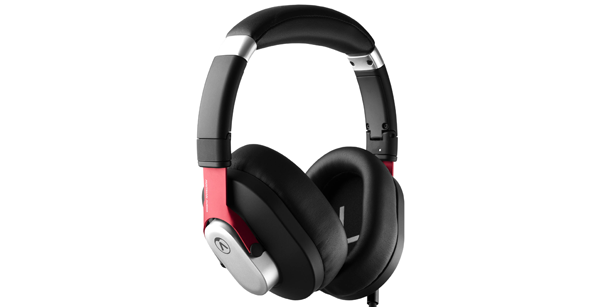
Austrian Audio Hi-X15
Buy it new on Sweetwater, B&H, Thomann, or Amazon. Look for deals on Reverb.
“Hi-X” stands for Austrian Audio’s “high excursion technology”. This design, which features a ring magnet system around a 44mm driver, reduces weight and provides a sound that’s more responsive, clearer, and offers increased sonic definition compared to the norm for the best closed back studio headphones in this range.
They feature durable all metal hinges which allow them to be folded and stored in their included carrying bag. It’s a sleek and attractive design with just a splash of color. The connecting cable is detachable, which minimizes the likelihood of breakage and eliminates having to solder a new one on if the cable ever needs to be repaired.
The frequency response of these headphones feels quite smooth, and stands as one of the major selling points of this model. There is ample low end, the midrange is clear, and the highs weren’t splashy in the least.
Like many of of the other models in the Hi-X line, these headphones do have a slight lift at 1kHz and a bit of a dip at 2kHz, which gives them their distinctive character. But otherwise, they come across as one of the more neutral and useful sounding options in this price range.
The memory foam ear pads are very comfortable, and should fit the average person easily. The isolation here is about average, and I could hear sounds outside the headphones while wearing them to a slightly greater degree than some of the best-isolated models on this list.
Like most headphones in this category, it comes with a 3.5mm connector and a ¼” adapter available. The specs state a frequency response of 12hz-24khz and a sensitivity of 113dBspl/V with an impedance of 25 Ω.
The least expensive model in the Hi-X line, these headphones carry a list price of $129 and can often be found for $119 street price.
Audio Technica ATH-M50X (Best Build Quality)
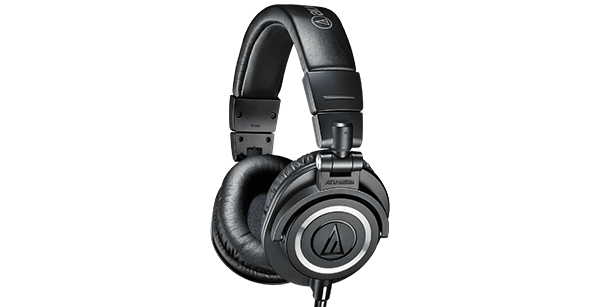
Audio Technica ATH M50X
Buy it new on Sweetwater, B&H, Thomann, or Amazon. Look for deals on Reverb.
The ATH M50X are well built and sturdy. If you’re looking to stock a commercial recording facility with high quality cans, these headphones are a great choice.
Their thick foam padding offers excellent isolation and minimal leakage with a tight fit. The earpieces pivot easily for one ear monitoring—a great feature for a pair of recording headphones.
They are built around a 45mm driver with copper-clad aluminum voice coils, and the specs show a frequency response of 15-28k kHz and a sensitivity of 99dB at an impedance of 38 ohms.
The frequency response comes across as smooth and not hyped. The low end here feels slightly less tight and less pronounced as on some of the other models on this list, but you can still hear it well. Relative to the Austrian Audio and Blue models on this list it, it has a bit less low end extension and a bit more high end clarity.
It ships with a carrying pouch, a ¼” adapter and three detachable cables. The cables are a 1.2m straight, 3m straight, and a 1.2-3m coiled cable. The ATH-M50X sell for $169.
Blue Lola and Mix-Fi (Best Low End)
Blue’s Lola model looks, feels, and sounds different than the rest. The design is very usual looking with a bit of artistic flair, but they’re actually very comfortable to wear. Blue explains that the “racecar-inspired” design keeps the ear cups parallel for a better experience. It uses a 50mm fiber-reinforced driver operating at 42 ohms.
Also available are the Blue Mix-Fi model, which are practically identical, but with a built-in headphone amp that runs on rechargeable batteries that will hold up to 12 hours of playtime.
Both of these headphones sound really good. The sonic impression is very rich, with very ample yet tight and defined low end, prominent midrange, and a smooth, unhyped top end. These headphones go surprisingly deep in the bottom and could be an excellent low end reference check for small studios.
The enclosures are sealed with tuned damping materials, with a stated frequency response of 15Hz-20kHz. The fit was comfortable, with good over the ear coverage and nice rejection of outside sounds with extremely low leakage.
These headphones are closed back but, due to the low end detail and unhyped top end, they can even work for mixing applications. SonicScoop’s Justin Colletti even uses them as a secondary reference for mastering when traveling.
Also provided are a soft case with pocket for cable storage, and two types of cables: a 1.2 m smartphone audio cable with Apple iPhone controls, a 3m standard audio cable, and a ¼” adapter. Both are easily detachable.
The only problem with these headphones is that the surface covering on the earpads is known to disintegrate over time, and direct replacements are not available for them. While this is purely a cosmetic issue, it is a weak point in the design.
While the Lolas and Mix-Fis list for $200-$300, since they are being discontinued (probably due in part to this earpad issue) they can be found on sale regularly for below $200, allowing them to make this list.
Beyerdynamic DT 770 Pro (Best Comfort and Style)
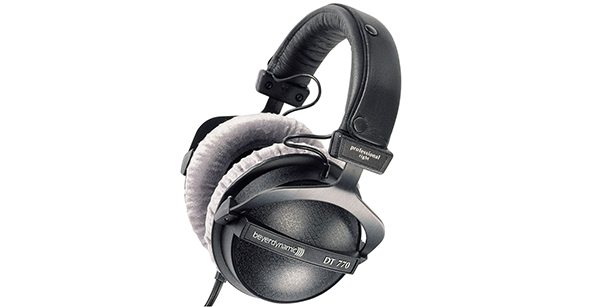
Beyerdynamic DT 770 Pro
Buy it new on Sweetwater, B&H, Thomann, or Amazon. Look for deals on Reverb.
Beyerdynamic’s headphones have some serious fans, thanks in part to how comfortable they are to wear and listen to over long periods.
Although these headphones are a little bulky, the head band is quite comfortable and the soft, velvety earpads make them easy to wear for a long time—even while wearing glasses.
They offer their DT 770 Pro in three different impedance levels, so if you want better listening on your low output mobile devices, the 32 ohm model would be best. Their “Universal Studio” version runs at 80 ohms and plays nicely in many applications, while the model I used was the 250 ohm “Pro” version.
The circumaural fit is excellent and there is good isolation and minimal leakage. As far as sound, they come across as decidedly “smooth”, with a bigger and tighter bottom end than some other models, complemented by lift in the higher frequencies.
The one compromise with the Beyerdynamic line in general, is that this pleasant, smooth signature sound comes at a price: The upper mids and high frequencies here are voiced to be pleasant more so than “flat”. There is a dip in the low mids and upper midrange relative to most other headphones in this price range, with a slight boost in the lows and highs.
They can still be useful for making critical listening decisions, once you get used to them. Just be aware of a dip around 200Hz and 4kHz, and a bit of a sparkly lift around 8kHz and 10kHz. This makes them fun to listen to, but requires a little bit of extra trial and error to make decisions that translate across all listening environments.
The DT 770 ships with a ¼” adapter and a draw string bag, and the specs say the frequency response is 5-35K Hz with an SPL of 96.
They are durable and seem like they would stand up well in a commercial facility. As of now, Beyerdynamic is offering them at a reduced price of $139.
Sennheiser HD 280 Pro (Best Value for Recording Studios)
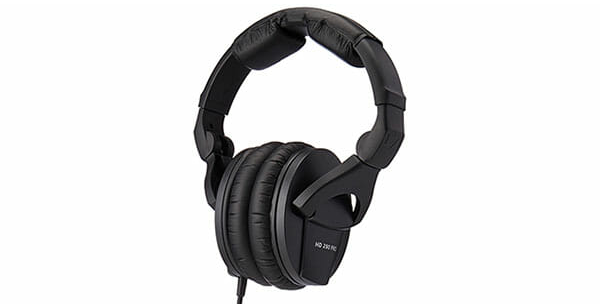
Sennheiser HD 280 Pro
Buy it new on Sweetwater, B&H, Thomann, or Amazon. Look for deals on Reverb.
First introduced in 2003, these headphones are a staple in many recording studios. Sennheiser says “the HD 280 Pro boasts extremely robust construction” and they aren’t exaggerating.
Many studio owners love these headphones for how affordable and seemingly unbreakable they are, while still offering good sound quality and isolation. If you need a lot of headphones that stand up to the rigors of constant use and abuse, these are one of the best bets out there.
These headphones feel light but sturdy and offer a good circumnaural fit with very good isolation and minimal leakage. Although their cable is not detachable, it does not seem to be a common failure point, with most users agreeing that they are very durable in practice.
Specs show a frequency response of 8-25k Hz with an SPL of 113 dB with an impedance of 64 ohms. A common complaint is that the headphones feel a bit midrangey, light both in the bass and the top end.
While not likely to be the most inspiring headphones you’ll ever own, and probably not well-suited for critical listening decisions, they are an absolute workhorse for tracking situations.
Comfortable in fit and decent in sound, these would be a good pair for long tracking sessions. The HD 280 Pro is listed at just $99.95.
Sony MDR-7506 (Best Classic Cans)
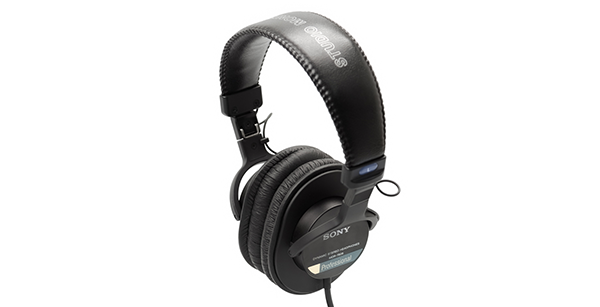
Sony MDR 7506
Buy it new on Sweetwater, B&H, Thomann, or Amazon. Look for deals on Reverb.
The venerable MDR 7506 headphones are lightweight, loud, and comfortable to wear, with a distinctly bright and detailed sound. They’re a design that’s over 30 years old and still popular to this day.
The driver assembly doesn’t cover the ear quite as well as others on this list, and while there’s decent enough isolation here, they do exhibit more leakage than some other models we’ve looked at.
They’re not short on volume output though! The sound here is a bit “hyped up”, featuring a trademark boost in the upper mids starting around 4kHz and running up through 10kHz, as well as a loosely booming low end boost at 100Hz, before rolling off at the extreme lows and highs.
In between however, the midrange is relatively flat for headphones—even though there’s a bit more THD going on here than in some of the more modern models on this list. If you like their distinctive and forward sound, they can be quite fun and engaging to listen to. But if you’re using them to make critical decisions, they take some trial and error for best results.
This combination of exciting, hyped-up sound quality, durability, and affordable price point make them one of the most ubiquitous closed back studio headphones on the market to this day.
Many producers and engineers who have been in this game a long time have developed a memory for how they sound and translate, and can get great results out of them. Meanwhile many new musicians enjoy the way they sound right out of the gate, finding them inspiring to perform with.
This popular budget headphone model has a 40mm driver which specs out at 10-20k Hz with an impedance of 63 ohms and a sensitivity of 106 dB. These are hard wired, with an ample 9.8 coiled cable terminating with a 3.5mm tip. The MDR-7506 ships with a ¼” adapter and a drawstring pouch.
Conclusion
Any of the headphones that made this list could serve you well. Each style has its own fans, strong points and tradeoffs. Just as there are many different recording situations and personality types, there are many possible offerings available to meet them. Good luck with yours!
Rick Slater is an audio professional, writer, and educator in the New York Metropolitan area.
Special thanks to AJ Tissian at The Wave Lab, NYC for hosting this shootout.
Please note: When you buy products through links on this page, we may earn an affiliate commission.







